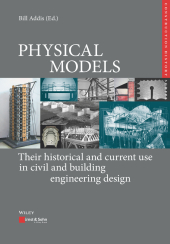 Neuerscheinungen 2020Stand: 2020-02-01 |
Schnellsuche
ISBN/Stichwort/Autor
|
Herderstraße 10
10625 Berlin
Tel.: 030 315 714 16
Fax 030 315 714 14
info@buchspektrum.de |

Bill Addis, Karl-Eugen Kurrer, Werner Lorenz
(Beteiligte)
PHYSICAL MODELS
Their historical and current use in civil and building engineering design
Herausgegeben von Addis, Bill; Kurrer, Karl-Eugen; Lorenz, Werner
1. Auflage. 2020. 600 S. 400 SW-Abb., 10 Tabellen
Verlag/Jahr: ERNST & SOHN 2020
ISBN: 3-433-03257-2 (3433032572)
Neue ISBN: 978-3-433-03257-2 (9783433032572)
Preis und Lieferzeit: Bitte klicken
Physical models have been, and continue to be used by engineers when faced with unprecedented challenges, when engineering science has been non-existent or inadequate, and in any other situation when the engineer has needed to raise their confidence in a design proposal to a sufficient level to begin construction. For this reason, models have mostly been used by designers and constructors of highly innovative projects, when previous experience has not been available.
The book covers the history of using of physical models in the design and development of civil and building engineering projects including bridges in the mid-18th century, William Fairbairn?s Britannia bridge in the 1840s, the masonry Aswan Dam in the 1890s, concrete dams in the 1920s, thin concrete shell roofs and the dynamic behaviour of tall buildings in earthquakes from the 1930s, tidal flow in estuaries and the acoustics of concert halls from the 1950s, and cable-net and membrane structures in the 1960s.
Traditionally, progress in engineering has been attributed to the creation and use of engineering science, the understanding materials properties and the development of new construction methods. The book argues that the use of reduced scale models have played an equally important part in the development of civil and building engineering. However, like the history of engineering design itself, this crucial contribution has not been widely reported or celebrated.
The book concludes with reviews of the current use of physical models alongside computer models, for example, in boundary layer wind tunnels, room acoustics, seismic engineering, hydrology, and air flow in buildings.
Bill Addis, born in 1949, studied engineering sciences and philosophy at the University of Cambridge before working as an engineer in the aerospace industry. He later spent over 15 years in the Department of Construction Management at the University of Reading, and then 15 years as a consulting engineering with the firm Buro Happold in London. He developed his interest in building and civil engineering history, and in the use of model testing during five decades, including work on his doctorate on the history and philosophy of engineering. He has written several books and over a hundred academic papers on the history of building engineering and construction, and has recently been enjoying lecturing and research as a visiting professor in universities in Rome, Innsbruck, San Sebastian, Zurich, Brussels and Munich.


